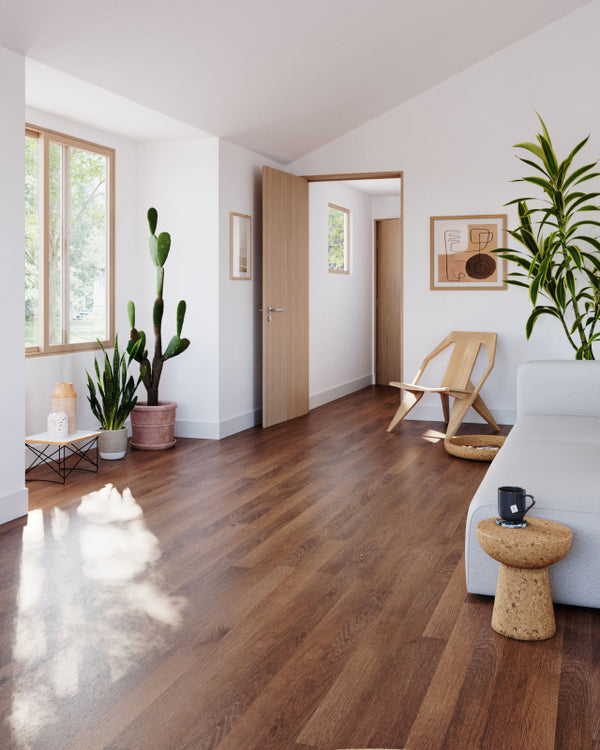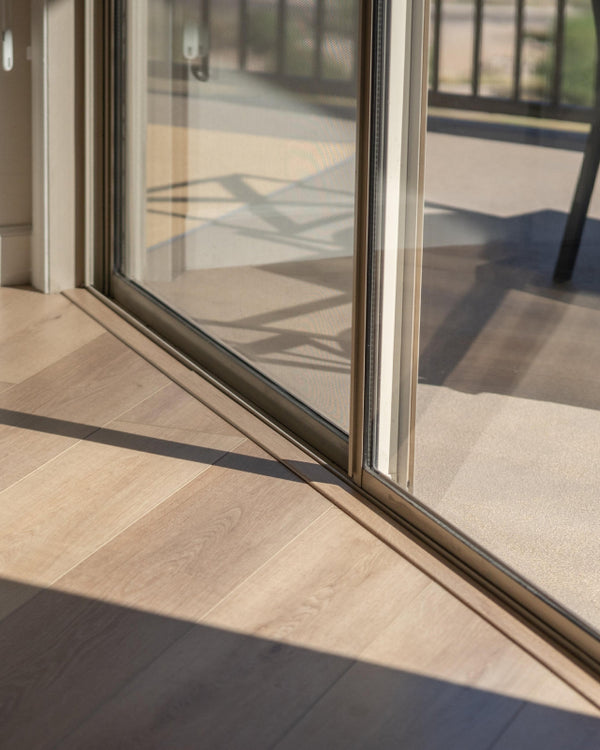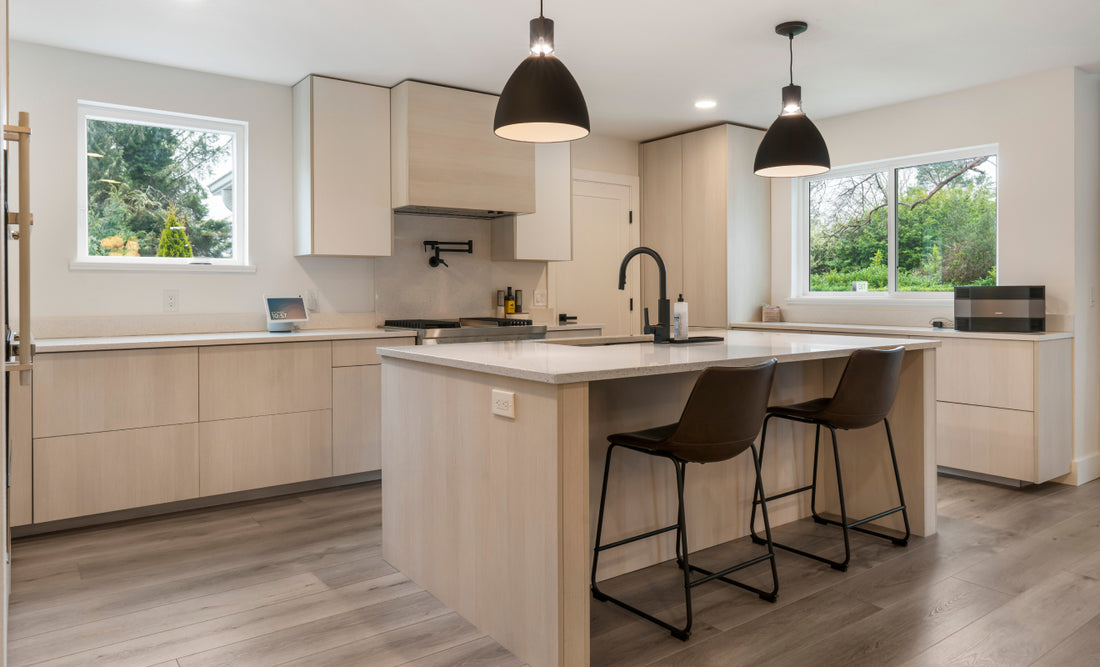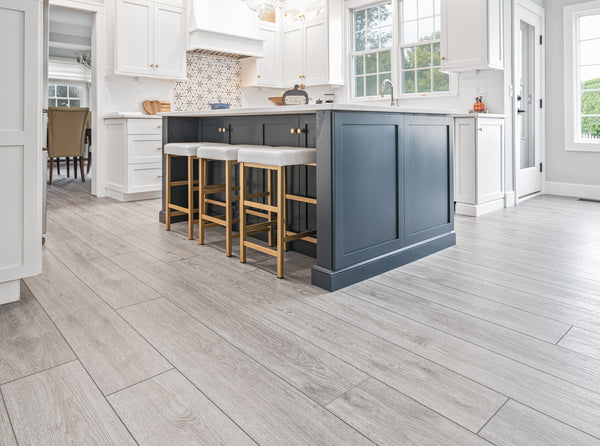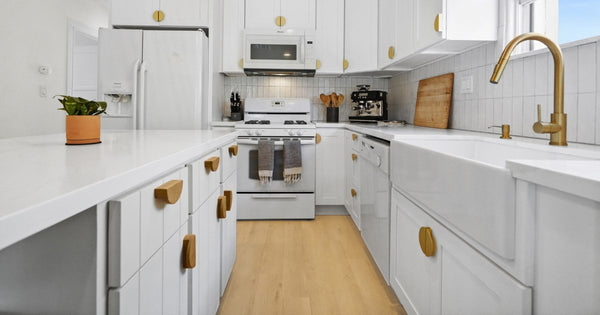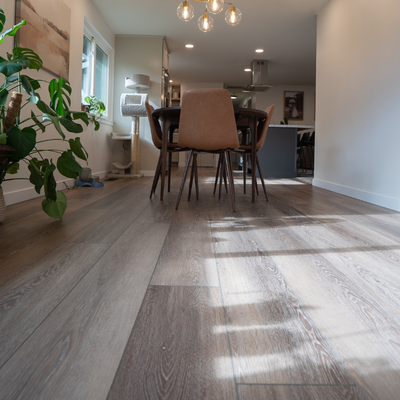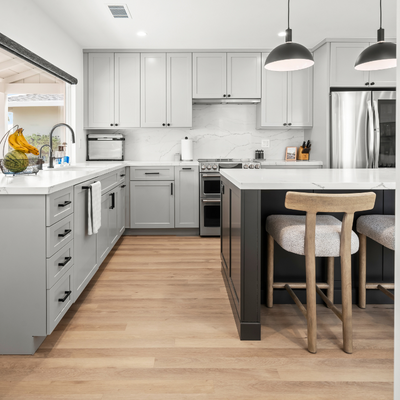Whether you're looking to elevate your home decor or need a resilient flooring option that can handle the demands of a busy household, Luxury Vinyl Plank flooring offers a sophisticated solution that doesn't compromise on quality or style.
If you’re new to LVP, we’ve compiled a guide to help you understand the basics, including what specs to look out for, necessary purchases, subfloor requirements, and how to get started.
What is Luxury Vinyl Plank Flooring?
Luxury vinyl plank flooring, or LVP, offers the perfect blend of durability and style, making it an increasingly popular choice among homeowners. Unlike traditional sheet vinyl or individual tiles, LVP is crafted from planks that mimic the look and feel of real wood. This wood-look product not only captures the timeless beauty of hardwood but also brings additional benefits such as ease of installation, waterproof properties, and impressive durability. With its thick, insulating design, LVP is well-suited for high-traffic areas, offering resistance to scratches, spills, and everyday wear and tear. For those seeking an affordable yet elegant flooring solution, LVP stands out as an excellent alternative to more expensive flooring options.
The appeal of LVP extends beyond its practicality; modern printing technology allows for a wide array of stylish design options, replicating the rich visuals of hardwood or even stone. This means that homeowners can achieve the luxurious appearance of natural materials at a fraction of the cost.
Our Modin LVP Collection exemplifies this versatility, featuring three distinct models: Signature, Base, and Craftsman. Each model in this collection is 100% waterproof and boasts a true embossed-in-register texture, a pre-attached underlayment for added comfort, and a rigid core for enhanced durability.
What Thickness of LVP Should I Choose?
When selecting luxury vinyl plank (LVP) flooring, thickness is an important factor that impacts both durability and comfort. LVP typically ranges from 4mm to 8mm in thickness, with each option catering to different needs and preferences.
- Standard Thickness (4mm-5mm): LVP within this range offers a solid balance of durability and comfort, making it well-suited for most residential settings. It’s ideal for areas with moderate foot traffic, providing enough resilience without compromising on comfort. For example, our Modin Base model features 5mm planks, delivering reliable performance for everyday use.
- Enhanced Thickness (6mm-8mm): For high-traffic areas or those seeking extra comfort underfoot, thicker LVP planks are a good choice. Planks in this range not only provide increased durability but also offer improved sound insulation and can help smooth out minor subfloor imperfections. Our Modin Signature and Craftsman models, with their 7mm planks, are perfect for those who want an elevated level of comfort and performance in their flooring.
What Wear Layer Should I Look For?
Wear layer is the durable layer of PVC on top of the realistic print film. It stands up to wear and tear, preserving and protecting your floors. The best wear layers are made of thick, clear, virgin PVC. Once the wear layer has worn through, the floor will need to be replaced. So, the thicker the wear layer, the better.
Your average vinyl floor will typically come with an 8-12 mil wear layer (0.2-3 mm). The top commercial specs in the industry are higher at 20-22 mil (0.5 mm). A select few manufacturers offer a “super” commercial spec of 28 mil (0.7 mm).
At Flooret, we took it a step further. Our Modin Signature and Modin Craftsman collections are built with a 40 mil (1.0 mm) wear layer.
We recommend opting for the thickest one you can afford so you can enjoy floors that look great and last for years to come.
What Else Will I Need to Buy?
When installing LVP flooring, there are a few additional items you might need:
- Underlayment: You do not need an additional underlayment with our Modin LVP Collection, which comes with a pre-attached underlayment and is designed to install directly over your existing flooring or subfloor. Depending on the brand of LVP you choose and your subfloor, an underlayment might be required. Underlayment provides additional cushioning, noise reduction, and can help with minor subfloor imperfections. You can learn more about underlayment here.
- Transition Pieces: These are essential for areas where your LVP flooring meets other types of flooring, such as tile or carpet. Transition pieces such as T-molding and Reducers help create a smooth transition and prevent tripping hazards. Other pieces like Quarter Rounds help cover expansion gaps where baseboard can't be used. You can find all Modin LVP compatible transition pieces on our website here.
- Flooring Adhesive or Click Lock System: Most LVP flooring options, including our Modin LVP Collection, use a click-lock installation method, which doesn’t require adhesive. However, if your LVP requires glue-down installation, you’ll need the appropriate adhesive.
Does LVP Come with a Subfloor?
LVP flooring does not come with a subfloor. Instead, it is designed to be installed over an existing subfloor. The key is to ensure your subfloor is clean, dry, and flat before installation. Any imperfections in the subfloor can affect the performance of your LVP flooring. If you’re installing over a concrete slab, be sure to use a moisture barrier such as a polyethylene moisture barrier, which should be available at your local hardware store.
Our Modin LVP planks can be installed over a variety of finished floors including single layer resilient sheet floor and tile, ceramic, marble, and terrazzo. A few important things to note:
- The surface must be in good condition and show no signs of excessive moisture conditions.
- Do not install flooring over heavily cushioned floors such as rubber or cork, or over tile installed over concrete below grade level.
- Do not install over any type of carpet.
- The grout joints in ceramic tile and marble must be leveled so they are flush with the tile surface. Additionally, the tile may require several skim coats to achieve a flat surface.
Installing LVP over an existing floor? Learn more here.
What Tools Will I Need to Install My LVP floors?
We recommend using the following tools to complete your installation of Modin LVP:
- Miter Saw
- Table Saw (most precise for cutting planks lengthwise)
- Tape Measure & T Square
- Universal tapping block
- Pull bar
- Heavy mallet
- Straight Edge & 1/4” Spacers
Getting Started with Your LVP Flooring
The first step in your flooring journey is to order samples. This allows you to compare colors, plank sizes, and test the durability of different options, ensuring you select the perfect flooring for your unique space. We offer a variety of sample kits to help you get started, or you can order cut samples of your favorite colors.
If you have any questions along the way, our expert support team is here to assist. Whether you prefer chatting with us online or calling us at 1-800-700-8121, we're ready to help you every step of the way. For more information or to explore our full range of LVP flooring options, visit Flooret and discover the ideal solution for your home.
